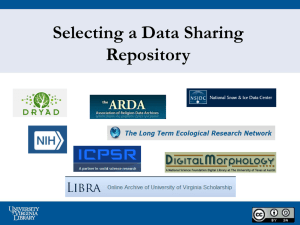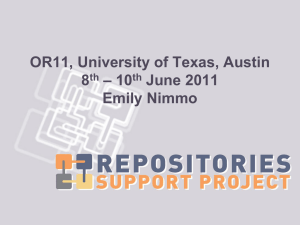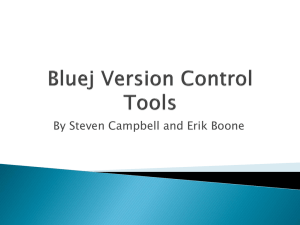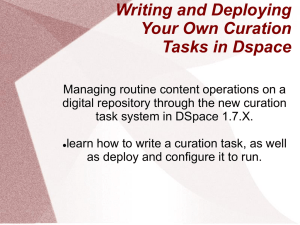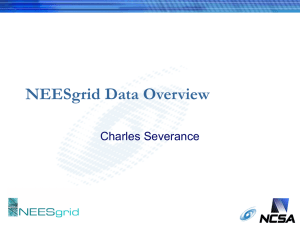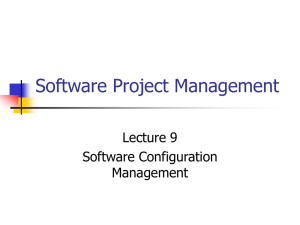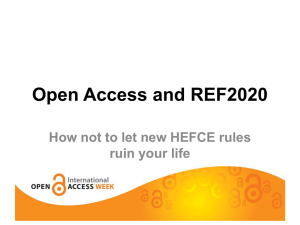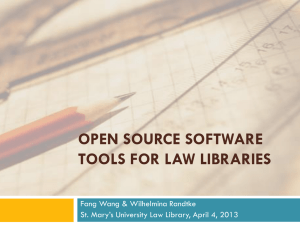Casate_Kuchma
advertisement
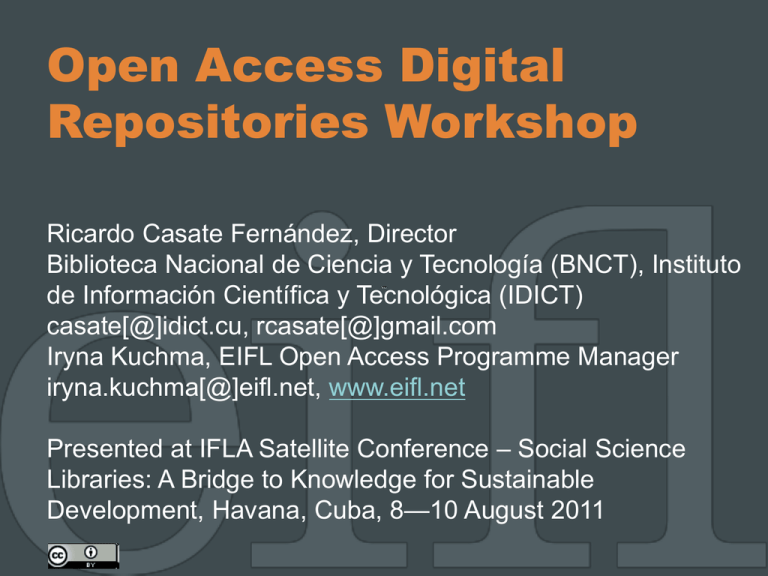
Open Access Digital Repositories Workshop Ricardo Casate Fernández, Director Biblioteca Nacional de Ciencia y Tecnología (BNCT), Instituto de Información Científica y Tecnológica (IDICT) casate[@]idict.cu, rcasate[@]gmail.com Iryna Kuchma, EIFL Open Access Programme Manager iryna.kuchma[@]eifl.net, www.eifl.net A ttribution 3.0 U nported Presented at IFLA Satellite Conference – Social Science Libraries: A Bridge to Knowledge for Sustainable Development, Havana, Cuba, 8—10 August 2011 Removing barriers to knowledge sharing EIFL-OA: open access EIFL-OA in action… Build capacity to launch OA repositories & to ensure their long-term sustainability Advocate nationally and internationally for the adoption of OA policies and mandates Provide guidance, expertise & support material during implementation of OA projects (policies, journals, repositories, books, data, OERs) Empower library professionals, scholars, educators and students to be OA advocates EIFL-OA in action… (2) 400 OA repositories & 2,500+ OA journals in EIFL partner countries (in the beginning of 2010 – 186 OA repositories) OA policies have been adopted by 24 institutions in the EIFL network 44 awareness raising, advocacy and capacity building events and workshops in 2008-2011 in 28 countries with participants from over 50 countries OA repositories Visibility, access, and preservation were the most important motivations cited by participating institutions to establish a repository. Other motivations included the need to evaluate researchers and departments, and as a response to requests from faculty. (A survey “Open Repository Development in Developing and Transition countries” conducted by EIFL and the University of Kansas Libraries) OA repositories (2) Which departments or units within your institution have actively advocated the establishment of a repository? 88% library 28% Information Technology department 18% administration 16% academic departments 14% research office (A survey “Open Repository Development in Developing and Transition countries”) OA repositories (3) Increase impact and usage of institute's research, providing new contacts and research partnerships for authors. Provide usage statistics showing global interest and value of institutional research. FOSS to set up, free technical support. Low installation and maintenance costs, quick to set up and gain benefits. Institutions can mandate OA, speeding development. Aims to enhance greater visibility and application of research outputs through global networks of OA digital repositories http://coar-repositories.org/ How to start Making a Case: Explaining the need for a repository and the expected benefits Strategic Planning and Business Cases Defining Scope and Planning Checklists (based on the Proposed checklist for the implementation of an Institutional Repository Developed by the Department of Library Services in the University of Pretoria, South Africa) Assumptions 1. Management has approved the implementation of an institutional repository (IR) (Proposal). 2. A server is in place to host the IR. 3. An IR Manager (project leader) has been identified to manage the project – and will have to do most of the work initially. Step 1 Start with a repository Steering Group (or Project Board, Management Committee, Working Group, etc.) that undertakes the high level management of a repository on behalf of the Institution. Involve key stakeholders: senior management and policy makers, academic staff, library staff, technical support staff, other support staff. Steps 2-3 Step 2. Assign a project leader (IR Manager), and identify members to form part of the implementation team (e.g. external consultant, copyright officer, metadata specialist/ head cataloguer, digitization specialist, 2-3 subject librarians, IT etc.). Step 3. Identify 1 to 4 champions at the faculty to work with initially. Involve them in your meetings and make them part of the implementation team. Steps 4-8 Step 4. Conduct a needs analysis and compile a needs analysis report Step 5. Evaluate available software and decide on which software to use. Step 6. Join existing mailing lists. Step 7. Start thinking of a name for the IR. Step 8. Decide on how collections will be structured within the IR. Top reasons to use DSpace Largest community of users and developers worldwide Free open source software Completely customizable to fit your needs Used by educational, government, private and commercial institutions Can be installed out of the box Can manage and preserve all types of digital content Top reasons to use EPrints As the first professional software platform for building repositories, EPrints is already established as the easiest and fastest way to set up repositories. It is intended to create a highly configurable webbased repository. EPrints is often used for research papers, and the default configuration reflects this, but it is also used for other things such as images, research data, audio archives - anything that can be stored digitally. Step 9: Define workflows 33% material to be collected by staff members or librarians independently of the authors or researchers; 30% researchers and authors provide content to specialised staff members or librarians to deposit into the repository; 17% self-depositing by researchers and authors with quality control by specialised staff members; 13% self-depositing by researchers and authors with no quality control by specialised staff members. (A survey “Open Repository Development in Developing and Transition countries”) Step 10. Discuss licensing & copyright issues with the legal department. A comprehensive deposit and end user’s license agreement should cover a number of core topics, including • a depositor’s declaration • the repository’s rights and responsibilities • and the end-user’s terms and conditions Depositor’s Declaration 1. to ensure that the depositor is the copyright owner, or has the permission of author/copyright holder (if by proxy) to deposit 2. the author and any other rights holders grant permission to the host institution to distribute copies of their work via the internet... 3. the author has sought and gained permission to include any subsidiary material owned by third party copyright holders Repository's rights & responsibilities It must be made clear to the submitting author that through submission of their work the copyright ownership is unaffected. One way of doing this is for the deposit license to begin with the author granting the repository the nonexclusive right to carry out the additional acts... End-user's terms and conditions open access – free of charge & free of most usage restrictions online access to research literature the author(s)/copyright holder(s) should make the best efforts to grant to all users a free, irrevocable, worldwide, perpetual right of access to, and a license to copy, use, distribute, transmit and display the work publicly and to make and distribute derivative works, in any digital medium for any responsible purpose, subject to proper attribution of authorship End-user's terms and conditions open access – free of charge & free of most usage restrictions online access to research literature the author(s)/copyright holder(s) should make the best efforts to grant to all users a free, irrevocable, worldwide, perpetual right of access to, and a license to copy, use, distribute, transmit and display the work publicly and to make and distribute derivative works, in any digital medium for any responsible purpose, subject to proper attribution of authorship Steps 11-14 Step 11. Compile a business plan and present to management. Step 12. Register project with IT department and establish a service level agreement. Step 13. Incorporate IR as part of role description for cataloguers & subject librarians. Step 14. Start working on IR policy, and continue to document all important decisions taken. Steps 15-17 Step 15. Identify faculty members, which will participate in the evaluation, and present a training session on how to use the software. Step 16. IT staff deploys software on developmental server and implementation team and other role players evaluate, then moving to the quality assurance server and then to the production server. Step 17. Create Collections for faculty champions and populate in order to demonstrate to library staff and community Steps 18-19 Step 18. Register IR with international harvesters, search engines, have it listed on web pages etc (See http://www.jiscinfonet.ac.uk/infokits/repositories/t echnical-framework/registering and http://www.jiscinfonet.ac.uk/infokits/repositories/t echnical-framework/search). Step 19. Start developing a marketing presentation (which can be customized for specific subject areas), marketing leaflets, training material, online help e.g. copyright clearance process Marketing Open repository for researchers Long term preservation and back-up Usage statistics Web-presences – personal profiles, actual CVs, publication lists Opportunities Citations Collaborative projects Financing Marketing Open repository for research managers Information & research management Quality assurance: statistics, web metrics, etc Web-presences – personal profiles Marketing Competitiveness Print-on-demand Virtual learning environment Opportunities Collaborative projects, Financing, Good students Steps 20-21 Step 20. Introduce IR to rest of community (departments, individuals, etc). Host open sessions over lunch hour, use organisational newsletters, present at meetings & conferences. Step 21. Invite all to register new collections. Communicate procedure on e.g. IR home page. Frequently communicate e.g. via e-mail, monthly newsletter, etc. Frequently communicate statistics Steps 22-23 Step 22. Launch IR when ready. Invite administration, heads of faculties & departments, other key-players, etc. Step 23. Budget each year and plan for the following year. Keep monitoring server capacity, stay updated through mailing lists and reading articles, attending conferences etc. Staffing requirements Repository Manager - who manages the ‘human’ side of the repository including content policies, advocacy, user training and a liaison with a wide range of institutional departments and external contacts. Repository Administrator - who manages the technical implementation, customisation and management of repository software, manages metadata fields and quality, creates usage reports and tracks the preservation issues See: http://www.sherpa.ac.uk/documents/Staff_and_Skills_Set_2009.pdf Content acquisition guidelines Advocacy Options Top-down Explore institutional requirement for deposit (mandates) Obtain supporting statements from the very highest level of the institution Invite stakeholders to join repository steering groups Keep the Pro-VC for research (or similar) and key committees informed of developments and successes. This ensures the repository is embedded in the organisation. Content acquisition guidelines (2) Advocacy Options Bottom-up Locate repository champions. Enthusiastic early adopters can act as change agents, taking your messages out on a peer-to-peer basis Demonstrate how new researchers can contribute, and gain a flying start to their careers. Repository usage statistics can provide powerful encouragement Content acquisition guidelines (3) Advocacy Options Bottom-up Engage students, especially graduates, by promoting the use of open access research material. In turn they will influence their peers and mentors Inform and involve support staff, ensuring they understand the importance of the repository to the institution's strategy Content acquisition guidelines (4) Advocacy Options Targeted Identify so-called 'green' publishers - those who allow self-archiving in any form - and then asking the academics who have published in those journals for permission to deposit those papers in the institution's institutional repository. To check the list of publisher copyright policies on self-archiving, visit RoMEO. Content acquisition guidelines (5) Work with departments most likely to benefit from the repository, such as: those reviewing research management/reporting processes; subject areas with Funder Mandates; those who's academics publish in wide range of journal publications; subject areas with Open Access services such as PubMed Central and Arxiv (Based on The Digital Repositories infoKit: http://www.jiscinfonet.ac.uk/infokits/repositories/managementframework/options) Group work The planning checklist (adaptation from the Repository Support Project, the UK: http://www.rsp.ac.uk/) 1. What is an institutional repository and why does your organization need it? 2. Have you outlined and documented the purpose and drivers for institutional repository establishment in your institution? 3. Have you defined your vision and initial goals? Group work (2) 4. Have you decided how to position your institutional repository within your wider information environment? 5. What is the target content of the repository? 6. Do you have an institution wide intellectual property rights policy? How will you deal with licensing and copyright issues? 7. Do any of your Departments already have other digital stores of publications? How will you manage duplication, transfer of resources and metadata, etc.? Group work (3) 8. Does your institution have an information management strategy? Is your repository part of it? 9. Have you defined roles and responsibilities for your institutional repository development? 10. What sort of statistics and management reports will you want from your institutional repository? Have you decided if and how you will collect usage and item download statistics for your repository? Group work (4) Resourcing repositories for sustainability (adaptation from the Repository Support Project, the UK: http://www.rsp.ac.uk/) 1. Have you properly and fully specified the requirements of your repository? 2. What is the anticipated growth of your repository? 3. Are you running a pilot project or a production service? If the former, who, when, if and how will it transfer to a production service? Group work (5) 4. Who will answer support/help desk queries relating to the repository? 5. Have you considered how your repository may grow over the next year, 3 years, 5 years, 10 years? 6. Which digital formats can the repository commit to preserve in the longer-term? Is the repository collecting author source formats? Is there a viable action plan for monitoring the formats stored in the repository and the preservation risks associated with those formats? Do you know which tools are available to do this? Useful reading The Digital Repositories infoKit: http://www.jiscinfonet.ac.uk/infokits/repositories/index_html Open Access Scholarly Information Sourcebook by Alma Swan and Leslie Chan: http://www.openoasis.org SPARC Institutional Repository Checklist & Resource Guide: www.arl.org/sparc/bm~doc/IR_Guide_&_Checklist_v1.pdf Creating an Institutional Repository: LEADIRS Workbook: http://dspace.mit.edu/handle/1721.1/26698 A Guide to Developing Open Access Through Your Digital Repository by Open Access to Knowledge Law Project: http://www.oaklaw.qut.edu.au/node/32 Thank you Questions? The presentation is licensed with Creative Commons Attribution 3.0 License
